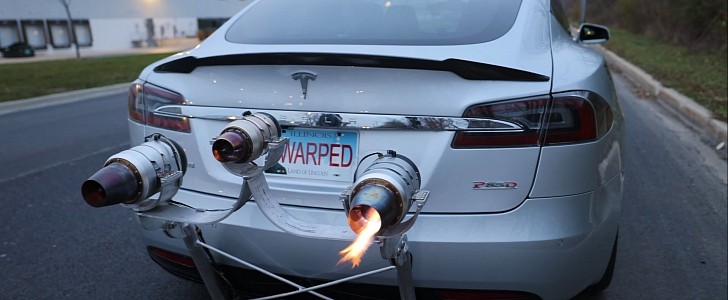Youtuber Matt Mikka attached three jet engines to his Tesla Model S, improving its 0-60 mph (97 kph) performance by almost one second. The move might be contrary to Elon Musk's mission to save the world, but Mikka did it anyway.
Well, the whole idea is not new, as Elon Musk himself promised the next Tesla Roadster will boast unprecedented acceleration thanks to its rocket thrusters. Those being a little hard to come by, many people tried jet engines instead, with varying degrees of success. Look, for instance, at this 1984 Pontiac Fiero jet-powered car.
Since this kind of arrangement might ruin an otherwise perfectly functional car, wise people from Warped Perception YouTube channel tried a different approach. That is, bolting three smaller jet engines to the back of a Tesla Model S P85D. Would they still offer a meaningful performance boost to work with or is it all just a waste of time and resources?
To find out, Matt Mikka performed several trials, with electric motors alone, jet engines alone, and all of them together. Surprisingly, he found out that two jet engines are enough to maintain 60 mph on the highway. Due to the small size of the engines, it is impossible to talk about a true “jet blast”. But they certainly improve acceleration, although not by much.
With all three jet engines running, the car ended almost one second quicker in its sprint from 0 to 60 mph. According to Matt, the boost would have been stronger has he chosen to mount the engines directly in the air stream. That would have prevented the starting of the engines while the car was running though and the airflow could have also damaged the delicate jet engines, due to the lack of lubrication when not in use.
Also, Matt believes he could get better figures on a hot summer day when the tires achieve a better grip. Jet engines, on the other hand, tend to perform better with cold air, so make of this what you will.
Since this kind of arrangement might ruin an otherwise perfectly functional car, wise people from Warped Perception YouTube channel tried a different approach. That is, bolting three smaller jet engines to the back of a Tesla Model S P85D. Would they still offer a meaningful performance boost to work with or is it all just a waste of time and resources?
To find out, Matt Mikka performed several trials, with electric motors alone, jet engines alone, and all of them together. Surprisingly, he found out that two jet engines are enough to maintain 60 mph on the highway. Due to the small size of the engines, it is impossible to talk about a true “jet blast”. But they certainly improve acceleration, although not by much.
With all three jet engines running, the car ended almost one second quicker in its sprint from 0 to 60 mph. According to Matt, the boost would have been stronger has he chosen to mount the engines directly in the air stream. That would have prevented the starting of the engines while the car was running though and the airflow could have also damaged the delicate jet engines, due to the lack of lubrication when not in use.
Also, Matt believes he could get better figures on a hot summer day when the tires achieve a better grip. Jet engines, on the other hand, tend to perform better with cold air, so make of this what you will.









